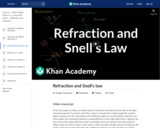
An introduction to Refraction and Snell's Law. Created by Sal Khan.
- Subject:
- Physical Science
- Physics
- Material Type:
- Lesson
- Provider:
- Khan Academy
- Provider Set:
- Khan Academy
- Author:
- Sal Khan
- Date Added:
- 12/08/2010

An introduction to Refraction and Snell's Law. Created by Sal Khan.
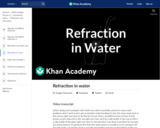
An introduction to Refraction in Water. Created by Sal Khan.

Through this concluding lesson and its associated activity, students experience one valuable and often overlooked skill of successful scientists and engineers communicating your work and ideas. They explore the importance of scientific communication, including the basic, essential elements of communicating new information to the public and pitfalls to avoid. In the associated activity, student groups create posters depicting their solutions to the unit's challenge question accurate, efficient methods for detecting cancer-causing genes using optical biosensors which includes providing a specific example with relevant equations. Students are also individually assessed on their understanding of refraction via a short quiz. This lesson and its associated activity conclude the unit and serve as the culminating Go Public phase of the Legacy Cycle, providing unit review and summative assessment.
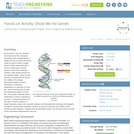
By this point in the unit, students have learned all the necessary information and conceptualized a design for how an optical biosensor could be used to detect a target strand of DNA associated with a cancer-causing gene as their solution to the unit's challenge question. Now student groups act as engineers again, using a poster format to communicate and prove the validity of the design. Successful posters include a description of refraction, explanations of refraction in a thin film, and the factors that can alter the interference pattern of a thin film. The posters culminate with an explanation of what is expected to be seen in a biosensing device of this type if it were coupled to a target molecule, proven with a specific example and illustrated with drawings and diagrams throughout. All the poster elements combine to prove the accuracy and viability of this method of gene detection. Together with its associated lesson, this activity functions as part of the summative assessment for this unit.
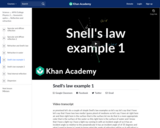
Snell's Law Example 1. Created by Sal Khan.
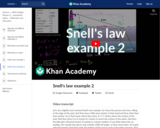
Snell's Law Example 2. Created by Sal Khan.
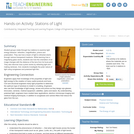
Student groups rotate through four stations to examine light energy behavior: refraction, magnification, prisms and polarization. They see how a beam of light is refracted (bent) through various transparent mediums. While learning how a magnifying glass works, students see how the orientation of an image changes with the distance of the lens from its focal point. They also discover how a prism works by refracting light and making rainbows. And, students investigate the polar nature of light using sunglasses and polarized light film.
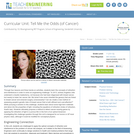
Through four lessons and three hands-on activities, students learn the concepts of refraction and interference in order to solve an engineering challenge: "In 2013, actress Angelina Jolie underwent a double mastectomy, not because she had been diagnosed with breast cancer, but merely to lower her cancer risk. But what if she never inherited the gene(s) that are linked to breast cancer and endured surgery unnecessarily? Can we create a new method of assessing people's genetic risks of breast cancer that is both efficient and cost-effective?" While pursuing a solution to this challenge, students learn about some high-tech materials and delve into the properties of light, including the equations of refraction (index of refraction, Snell's law). Students ultimately propose a method to detect cancer-causing genes by applying the refraction of light in a porous film in the form of an optical biosensor. Investigating this challenge question through this unit is designed for an honors or AP level physics class, although it could be modified for conceptual physics.
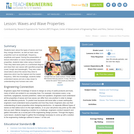
Students learn about the types of waves and how they change direction, as well as basic wave properties such as wavelength, frequency, amplitude and speed. During the presentation of lecture information on wave characteristics and properties, students take notes using a handout. Then they label wave parts on a worksheet diagram and draw their own waves with specified properties (crest, trough and wavelength). They also make observations about the waves they drew to determine which has the highest and the lowest frequency. With this knowledge, students better understand waves and are a step closer to understanding how humans see color.
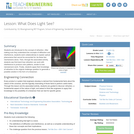
Students are introduced to the concept of refraction. After making sure they understand the concepts of diffraction and interference, students work collaboratively to explain optical phenomena that cannot be accounted for via these two mechanisms alone. Then, through the associated activity, students see first-hand how refraction can work with interference to produce color patterns, similar to how nanosensors work. Finally, students apply their knowledge of refraction to the original challenge question to generate a possible solution in the form of a biosensor.
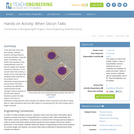
In the first half of this two-part activity, students practice solving problems involving refraction using the index of refraction and Snell's law equations; they mathematically solve for precise angles and speeds caused by refraction. In the second half of the activity, a hands-on lab, they apply the analytical skills required by the problem set to reflectance measurements of porous silicon thin films, including how reflectance measurements would change if various aspects of the film were altered. Students predict the data output in the form of reflectance measurements when samples are altered, which connects to the idea of being able to make predictions about the data output of a biosensing thin film that couples with a target molecule.